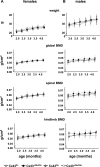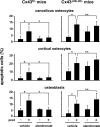Connexin 43 is required for the anti-apoptotic effect of bisphosphonates on osteocytes and osteoblasts in vivo
- PMID: 18597631
- PMCID: PMC2648607
- DOI: 10.1359/jbmr.080617
Connexin 43 is required for the anti-apoptotic effect of bisphosphonates on osteocytes and osteoblasts in vivo
Abstract
Connexin (Cx)43 is required for inhibition of osteocyte and osteoblast apoptosis by bisphosphonates in vitro. Herein, we evaluated its requirement for the in vivo actions of bisphosphonates using mice in which Cx43 was deleted specifically from osteocytes and osteoblasts (Cx43(DeltaOb-Ot/-) mice). Effective removal of Cx43 was confirmed by the presence of the deleted form of the gene and by reduced mRNA and protein expression in osteoblastic cells and bones obtained from Cx43(DeltaOb-Ot/-) mice. The amino-bisphosphonate alendronate (2.3 micromol/kg/d) was injected daily into 5-mo-old female mice (n = 6-11) for 31 days, starting 3 days before implantation of pellets releasing the glucocorticoid prednisolone (2.1 mg/kg/d). Cx43(DeltaOb-Ot/-) mice and their littermates (Cx43(fl/-), Cx43(DeltaOb-Ot/+), and Cx43(fl/+)) gained bone with similar kinetics and exhibited identical bone mass from 2 to 4.5 mo of age, indicating that Cx43 deletion from osteocytes and mature osteoblasts does not impair bone acquisition. In addition, prednisolone induced a similar increase in osteocyte and osteoblast apoptosis in Cx43(DeltaOb-Ot/-) or in control Cx43(fl/-) littermates. However, whereas alendronate prevented prednisolone-induced apoptosis in control Cx43(fl/-) mice, it was ineffective in Cx43(DeltaOb-Ot/-) mice. In contrast, alendronate inhibited glucocorticoid-induced bone loss in both type of animals, suggesting that inhibition of resorption is the predominant effect of alendronate against the early phase of glucocorticoid-induced bone loss. Taken together with earlier in vitro evidence, these findings show that Cx43 is required for the anti-apoptotic effect of bisphosphonates on osteocytes and osteoblasts.
Figures





Comment in
-
Connexin43 modulation of osteoblast/osteocyte apoptosis: a potential therapeutic target?J Bone Miner Res. 2008 Nov;23(11):1709-11. doi: 10.1359/jbmr.0811c. J Bone Miner Res. 2008. PMID: 18925861 Free PMC article. No abstract available.
References
-
- Batch JA, Couper JJ, Rodda C, Cowell CT, Zacharin M. Use of bisphosphonate therapy for osteoporosis in childhood and adolescence. J Paediatr Child Health. 2003;39:88–92. - PubMed
-
- Cummings SR, Karpf DB, Harris F, Genant HK, Ensrud K, LaCroix AZ, Black DM. Improvement in spine bone density and reduction in risk of vertebral fractures during treatment with antiresorptive drugs. Am J Med. 2002;112:281–289. - PubMed
-
- Falk MJ, Heeger S, Lynch KA, DeCaro KR, Bohach D, Gibson KS, Warman ML. Intravenous bisphosphonate therapy in children with osteogenesis imperfecta. Pediatrics. 2003;111:573–578. - PubMed
-
- Reid IR, King AR, Alexander CJ, Ibbertson HK. Prevention of steroid-induced osteoporosis with (3-amino-1-hydroxypropylidene)-1,1-bisphosphonate (APD) Lancet. 1988;1:143–146. - PubMed
-
- Saag KG, Emkey R, Schnitzer TJ, Brown JP, Hawkins F, Goemaere S, Thamsborg G, Liberman UA, Delmas PD, Malice MP, Czachur M, Daifotis AG. Alendronate for the prevention and treatment of glucocorticoid-induced osteoporosis. Glucocorticoid-Induced Osteoporosis Intervention Study Group. N Engl J Med. 1998;339:292–299. - PubMed
Publication types
MeSH terms
Substances
Grants and funding
LinkOut - more resources
Full Text Sources
Molecular Biology Databases

